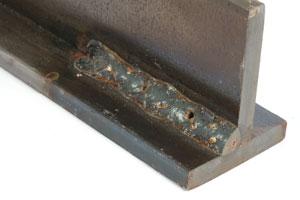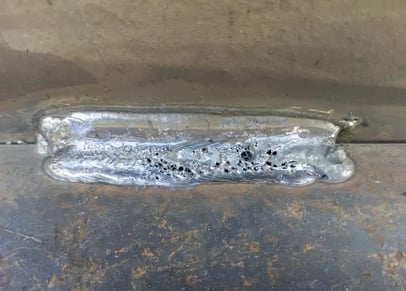What is Porosity in Welding: Comprehending Its Causes and Enhancing Your Skills
What is Porosity in Welding: Comprehending Its Causes and Enhancing Your Skills
Blog Article
Recognizing Porosity in Welding: Checking Out Causes, Results, and Avoidance Strategies
As experts in the welding industry are well mindful, comprehending the causes, effects, and avoidance techniques associated to porosity is critical for achieving robust and trusted welds. By diving right into the origin causes of porosity, analyzing its detrimental effects on weld quality, and exploring reliable avoidance strategies, welders can boost their expertise and skills to generate top notch welds constantly.
Usual Reasons For Porosity
Porosity in welding is mostly triggered by a mix of elements such as contamination, improper securing, and insufficient gas protection throughout the welding procedure. Contamination, in the form of dirt, oil, or corrosion on the welding surface area, develops gas pockets when heated up, resulting in porosity in the weld. Inappropriate protecting happens when the protecting gas, commonly made use of in processes like MIG and TIG welding, is not able to fully protect the liquified weld pool from reacting with the surrounding air, resulting in gas entrapment and succeeding porosity. Furthermore, inadequate gas insurance coverage, typically because of inaccurate flow prices or nozzle positioning, can leave components of the weld unsafe, allowing porosity to develop. These factors jointly add to the formation of spaces within the weld, deteriorating its integrity and potentially triggering architectural problems. Comprehending and dealing with these common reasons are crucial action in protecting against porosity and making certain the top quality and stamina of bonded joints.
Results on Weld Quality
The presence of porosity in a weld can substantially jeopardize the total quality and integrity of the bonded joint. Porosity within a weld creates voids or cavities that weaken the framework, making it extra at risk to splitting, deterioration, and mechanical failing.
Additionally, porosity can prevent the effectiveness of non-destructive testing (NDT) strategies, making it testing to identify other problems or suspensions within the weld. This can result in significant safety concerns, specifically in critical applications where the structural honesty of the welded parts is critical.

Avoidance Techniques Introduction
Given the damaging influence of porosity on weld top quality, effective prevention strategies are vital to keeping the architectural stability of bonded joints. Among the primary prevention strategies is complete cleaning of the base products prior to welding. Pollutants such as oil, oil, corrosion, and moisture can add to porosity, so guaranteeing a clean work surface area is important. Appropriate storage of welding consumables in dry problems is likewise critical to stop moisture absorption, which can cause gas entrapment throughout welding. Additionally, selecting the suitable welding criteria, such as voltage, existing, and take a trip rate, can help lessen the danger of porosity formation. Making sure appropriate shielding gas flow and insurance coverage is one more important avoidance technique, as insufficient gas coverage can cause atmospheric contamination and porosity. Appropriate welder training and qualification are important for carrying out preventive actions efficiently and consistently. By incorporating these avoidance strategies right into welding techniques, the incident of porosity can be considerably minimized, leading to more powerful and much more trustworthy welded joints.
Value of Appropriate Protecting
Proper shielding in welding plays a crucial function in avoiding climatic contamination and making sure the stability of welded joints. Securing gases, such as argon, helium, or a blend of both, are typically used to secure the weld swimming pool from reacting with components in the air like oxygen and nitrogen. When these reactive elements enter into contact with the warm weld swimming pool, they can trigger porosity, causing weak welds with minimized mechanical properties.

Insufficient protecting can lead to different problems like porosity, spatter, and oxidation, jeopardizing the structural integrity of the welded joint. Sticking to correct securing techniques is crucial to generate premium welds with minimal defects and make sure the long life and integrity of the bonded components.
Surveillance and Control Techniques
Exactly how can welders effectively keep track of and regulate the welding process to guarantee optimum outcomes and prevent flaws like porosity? By continually keeping track of these variables, welders can determine inconsistencies from the perfect conditions and make instant changes to prevent porosity formation.

Furthermore, applying proper training programs for welders is vital for checking and controlling the welding process effectively. What is Porosity. Informing welders on the value of preserving regular criteria, such as correct gas securing and travel speed, can help avoid porosity problems. Routine evaluations and accreditations can likewise guarantee that welders excel in surveillance and regulating welding procedures
In addition, making use of automated welding systems can boost surveillance and control capacities. These systems can specifically manage welding criteria, lowering the probability of human error and guaranteeing consistent weld quality. By combining innovative surveillance modern technologies, training programs, and automated Resources systems, welders can successfully keep track of and control the welding procedure to lessen porosity problems and achieve high-quality welds.
Verdict

Report this page